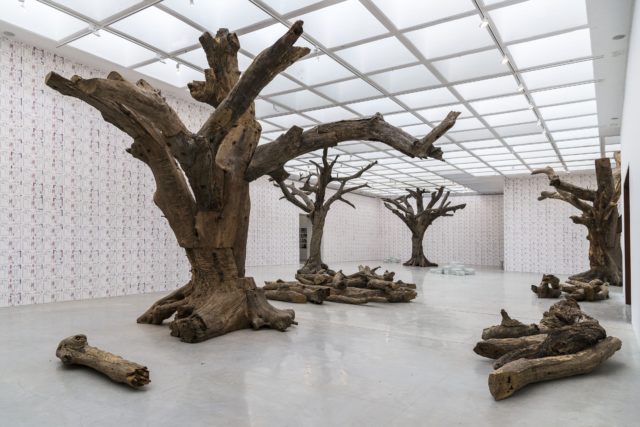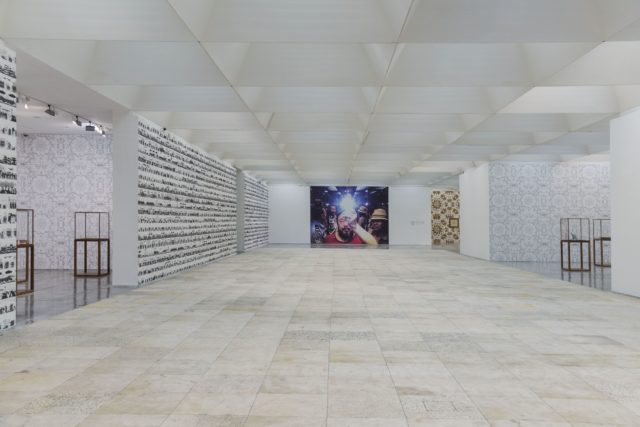For the first time in Israel, an exhibition by renowned Chinese artist and activist Ai Weiwei, one of the most prominent cultural figures of the 21st century, is now on view at the Israel Museum.
Ai Weiwei known for his monumental works combining large-scale installations with traditional Chinese handicrafts, addresses contemporary issues including human rights, freedom of expression, the refugee crisis, treatment of immigrants, and government censorship.
Will you offer us a hand? Every gift, regardless of size, fuels our future.
Your critical contribution enables us to maintain our independence from shareholders or wealthy owners, allowing us to keep up reporting without bias. It means we can continue to make Jewish Business News available to everyone.
You can support us for as little as $1 via PayPal at office@jewishbusinessnews.com.
Thank you.
Spread among a number of the Museum’s galleries, Ai Weiwei: Maybe, Maybe Not debuts new works and displays a series of installations that examine the relationship between individuals to their vast social culture.
Ai Weiwei ’s new monumentally-scaled Iron Tree—towering over 8 meters tall and weighing 14 tons— will greet visitors as they enter along the Museum’s promenade.
Inside, display of iconic installations including Trees, Soft Ground and Sunflower Seeds, —will be presented together with complementary works by the artist.
Ai Weiwei is renowned for making strong aesthetic statements that also resonate with timely phenomena across today’s geopolitical world.
In architecture and installations. In social media and documentaries. Ai Weiwei uses a broad range of mediums as expressions of new ways for his audiences to examine society and its values.
“Ai’s profoundly metaphorical body of work links contemporary Chinese culture with its past in ways that take on even deeper meaning in the setting of Israel, with its similarly ancient heritage,” said James S. Snyder, International President for the Museum’s worldwide activities.
“By shifting contexts—from China to Jerusalem—these installations reflect commonalities between these two civilizations, whose cultures developed concurrently over several thousand years on the eastern and western edges of Asia.” James S. Snyder added.
“Our collections,” he said,”covering a million and a half years of human creativity from around the globe, also offer a resonant setting for the universality of Ai’s work, centered on interconnections among history, place, and human experience.”
Maybe, Maybe Not features the following large-scale works, among others:
• Sunflower Seeds (2010): This sprawling and iconic installation are comprised of millions of porcelain sunflower seeds, handcrafted and painted by artisans from Jingdezhen, China’s porcelain capital, whose history traces back to the Han dynasty. Appearing together as a unified field, each seed reflects the individuality of its creator as compared with the mass production often associated with Chinese manufacturing. Eating sunflower seeds is ubiquitous across both China and Israel, and the discarded husks that dot each landscape give testimony to centuries of common social behavior.
• Trees (2010): Referencing the ancient tradition of collecting dry wood in appreciation of its form, Ai’s grove of tree sculptures is comprised of dead roots, trunks, and branches the artist gathered in the mountains of southern China. The work combines different species to create a semblance of a tree, whose artifice is apparent only upon closer inspection. These towering structures encourage an appreciation for the individual elements that combine to make a whole, a recurring motif in Ai’s practice. In Jerusalem’s olive tree-dotted landscape, Trees creates a special resonance with the religious and social meanings of trees in Israel. Extending this concept is Ai’s Iron Tree (2016), situated among the olive trees that line the Museum’s promenade and adorn its campus. Cast from nearly 100 fragments, held together by nuts and bolts, this sculpture is the most ambitious outdoor work the artist has created to date.
• Soft Ground (2009): Covering 250 square meters, this hand-woven carpet replicates in full detail the floor of the Haus der Kunst in Munich, commissioned by the Third Reich for the display of Nazi-approved art. Created in a weaving mill in Hebei province, it becomes a focal point for the intersection of the history of Chinese craftsmanship under imperial rule, modern history during the Nazi era, and labor practices in China today. Installed in the Israel Museum, Soft Ground also references the layering of Israel’s history from antiquity to the present.
The exhibition will be on view June 2 through October 28, 2017.






